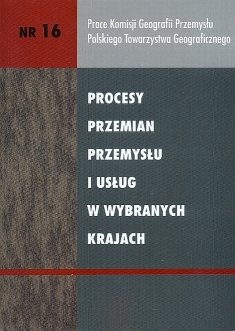Structural changes of world industry in post-industrial society and structural shifts in the world high-tech production allocation
DOI:
https://doi.org/10.24917/20801653.16.4Keywords:
world industry, post-industrial society, high-tech productionAbstract
This research is dedicated to the characteristic of structural spatial shifts of the world manufacturing industry. These trends have conduced to the restructuring of the world economy and main shifts in the manufacturing locations both at regional and global levels. On the one hand, countries have got a great chance to develop and to become active players in the world economy. On the other hand, those that fell behind the scientific and technological revolution, which started in the second part of the 20th century, and did not do their best to create new high technologies (or just did not have such opportunities because of a low level of development, illiteracy or people poorness) turned out to be behind global leading economies. Structural shifts both in manufacturing location and in industrial composition occur very quickly in the recent decades. There have been shifts in the HT-industry composition. The shift to developing Asian countries is fixed and there are some reasons for that. That is why the theme chosen for this paper is not very researched and rather burning. Moreover, it has practical importance for Russia, which in the current financial crisis once again has faced a choice to define the strategy of its further development.
Downloads
References
Gorkin A., 2008, The space organization of world manufacturing industry at the beginning of the XXI century: methodology and methodics of analysis /Bulletin of Peoples’ Friendship University of Russia. Series Economics, № 1. P. 23–31.
Gorkin A., 2004, The postindustrial industrial complex (problems and features of macro-geography) /Geography, society, environment. T. 5. The geography of socio-economic development. Moscow. P. 384–399.
Russia in figures, 2009, Brief statistical review. Short stat. Book. Federal Service of State Statistics (Rosstat): Mоckow.
Science and Engineering Indicators, 2008, (Appendix tables 6). Two volumes. National Science Foundation. USA. VA: Arlington, accessed online: http://www.nsf.gov.
Sluka N., 2007, The global city: theory and reality /Demoscop Weekly. Moscow.
Sluka N., Tkachenko T., 2009. The global city: specialities of industrial development /Changes of spatial organisation of world industry: ХХ в. – XXI в. /Edited prof. I. Rodionova. Econ-Info: Moscow.
UNIDO INDSTAT 2009. Industrial Statistics Database at the 4-digit Level of ISIC (Revision 2 and 3), 2009, accessed online: http://www.unido.org/index.php?id=4879).
World Development Report. 2009. Reshaping Economic Geography. World Bank. Washington. USA, accessed online: http://www.worldbank.org/publications.
Downloads
Published
How to Cite
Issue
Section
License
Articles are published under the terms of the Creative Commons License (CC BY-ND 4.0; Attribution– NoDerivs).

